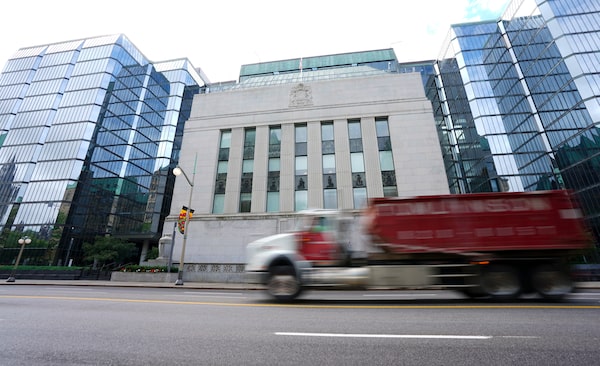
In the 31 years since the Bank of Canada instituted its 2-per-cent inflation target, inflation has never slipped this far out of the central bank’s grasp.Sean Kilpatrick/The Canadian Press
With every monthly release of Canada’s consumer price index, the gap between inflation and the Bank of Canada’s 2-per-cent target grows more cavernous – and the task to close it increasingly Herculean.
Frankly, it’s becoming hard to imagine that it won’t take a recession to get there.
Wednesday’s CPI report from Statistics Canada pegged the year-over-year inflation rate at 6.7 per cent in March, the highest since early 1991. It represents a leap of one full percentage point over February’s 5.7 per cent, which was itself a three-decade high.
When inflation is nearly triple your central bank’s target – regardless of the reason – it’s hard to argue that it’s not out of control. Indeed, in the 31 years since the Bank of Canada instituted its 2-per-cent inflation target, inflation has never slipped this far out of the central bank’s grasp.
Unquestionably, interest rates are far too low to address an economy that is straining at the limits of employment, with demand that has overshot supply capacity, and with inflation that is alarmingly high and still accelerating. What’s more, the bank’s 2-per-cent target looks less and less believable the more inflation runs away from it – escalating a major risk that consumers and businesses will lose their confidence that inflation can be sustainably returned to that distant target.
Millions of Canadian workers are taking an inflation-driven pay cut, report says
Inflation nation: Why the price of seemingly everything is on the rise
It’s now abundantly clear that the Bank of Canada will have to fix that, and fast. The economy’s long-term health and Canadians’ financial well-being – not to mention the bank’s hard-earned but increasingly strained credibility – depend on it.
Which means much higher interest rates, much faster than the Canadian economy is accustomed to handling. The risk may be shocking the economy into a recession. Unfortunately, anything short of that might be insufficient to break free of this deepening inflation spiral.
Before we go any further, a mea culpa. Yes, I believed the Bank of Canada’s argument for much of last year that the rising inflation rate was a transitory phenomenon, that it was being driven by some relatively short-term factors that would have begun fading by now. Yes, I thought inflation was nearing its peak about two percentage points ago.
The war in Ukraine rewrote that story. Instead of major inflation drivers such as supply chain problems and surging energy prices reversing themselves, those pressures have ramped up further, exacerbating global inflation woes before they had a chance to ease.
The lesson here is that when you have elevated inflation, transitory or not, you are exposed to serious risk that any surprises will send you even further off course. Now, the bank has a lot of work to do.
Despite raising its key interest rate to 1 per cent from 0.25 per cent since early March – including a bigger-than-normal 50-basis-point increase last week – the rate is still historically low, and highly stimulative for the economy. The Bank of Canada estimates that the neutral rate of interest – where the bank’s key rate is neither stimulating nor inhibiting economic activity – is between 2 and 3 per cent. Which suggests that the bank could triple its interest rate before it would no longer be, in effect, contributing to inflation. Until then, it’s easing off the accelerator, but not yet applying the brakes.
“Monetary policy tailored to current conditions should already be at neutral – if not above – given where inflation is and with a full-employment recovery, as the economy has moved into excess aggregate demand,” Bank of Nova Scotia economist Derek Holt argued in a research note Wednesday.
“Having failed to deliver that outcome, the second-best option would be to get to the midpoint of the 2-3 per cent neutral rate range this summer, and preferably by July, in my view.”
That implies 150 basis points of rate increases over the bank’s next two scheduled rate decisions (in early June and mid-July) in order to merely get the bank’s policy rate to an approximately neutral level.
Meanwhile, other forces will work against the Bank of Canada’s efforts in the coming months. Royal Bank of Canada economist Claire Fan noted that “exceptionally tight labour markets and a large stockpile of pandemic savings” will continue to fuel household spending even as borrowing rates move up rapidly.
That implies that the central bank may have to raise rates considerably above neutral to lean against these forces, and snuff out the economic momentum that would otherwise sustain inflation.
History has shown that when central banks fall behind the inflationary curve and have to accelerate their rate-hiking cycle, it’s more likely than not that the economy will tip into recession. And this could be an acceleration like we’ve never seen before.
If you’re as serious about inflation targeting as the Bank of Canada professes to be, tipping the economy into recession may be not only unavoidable, but desirable. This has gone too far to expect, or even hope for, a soft landing. It’s hard to imagine that this much inflation will be brought down by anything short of the reset that a recession would bring.
The Bank of Canada should be approaching policy with a view of managing it, not avoiding it.
Your time is valuable. Have the Top Business Headlines newsletter conveniently delivered to your inbox in the morning or evening. Sign up today.
 David Parkinson
David Parkinson